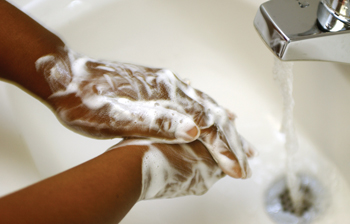
Compliance to hand-washing protocols is on the rise.
Photo by Dana Johnson
Hand-washing campaign seeing results
Data from observers in Vanderbilt's hospitals and clinics show improved compliance with health care industry standards for hand washing.
Moving throughout inpatient care areas of the Medical Center, these anonymous monitors have been quietly logging their observations of hand-washing practices.
“We've been gathering 30 to 40 observations a month,” said Tom Talbot, M.D., M.P.H., associate hospital epidemiologist.
“While monitoring efforts may provide only a crude measure, it's our most accurate available estimate of current practice.”
VUMC is some 18 months into a campaign to raise awareness about health care worker hand hygiene standards and the associated infection control benefits.
In inpatient areas, comparing the third quarter of 2004 (just before the start of the campaign) to the second quarter of 2005, monitors found 29 percent increased compliance with hand-washing standards.
Nurses started out with the best adherence of any group of VUMC employees, and they're the group shown to have improved the most since monitoring began, Talbot said.
“We still have room to improve,” Talbot said. “The challenge now is to sustain the hand-washing campaign without subjecting staff to message fatigue.”
Employees seen washing their hands are randomly treated to movie tickets and coffee coupons. In July, the campaign sponsors an annual awareness day with events around campus (such as last year's “Carnival of Clean Hands”).
Hand hygiene has been included in annual training requirements for faculty and staff who provide patient care.
A team provides brief awareness sessions, and hand hygiene reminders are present throughout patient care areas. Scores of additional alcohol gel dispensers have been placed throughout the Medical Center, and thousands of miniature containers of gel have been distributed to staff.
Talbot said he's looking for opportunities to extend hand-washing monitoring to outpatient areas.
According to the Centers for Disease Control, recent studies place hand hygiene adherence in hospitals at between 29 percent and 48 percent.
“Inadequate hand hygiene is considered the leading cause of health care-associated infections,” said Drew Gaffney, M.D., chief quality and patient safety officer.
Hand washing is both the easiest and most effective thing that can be done to prevent infections, Talbot said.
“Our goal is 100 percent adherence — anytime anyone works with a patient, he or she first needs to wash his or her hands. It's an ambitious goal, but I think we can attain it at Vanderbilt. And we're encouraged by the initial results of our monitoring program.”













